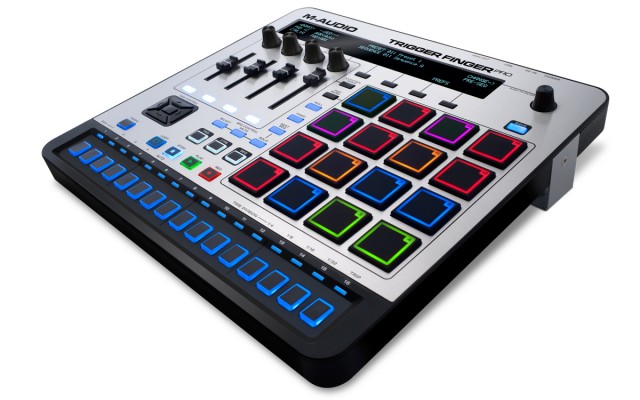This is not your father’s Trigger Finger.
The Trigger Finger has to be one of the biggest success stories in controllers, ever. Back before “controllerism” was a thing, this was what you took along – cheap, light, easy-to-abuse, it was a warhorse 4×4 grid of pads with faders. I’ve watched Flying Lotus tear up his; I’ve seen it win laptop battles. I’ve seen people play them with pads weirdly half ripped-off and all the knob and fader caps missing. I’ve seen Trigger Fingers that looked like someone dragged them through the mud tied to a pickup truck. (I knew that controllerism concert with Monster Trucks rally combo wasn’t a good idea.)
Well, now the Trigger Finger Pro USB controller is here, with a lot more controls. The pads light up with RGB color feedback, because, well, no pads anywhere will ever again escape the disco treatment. (Wasn’t there a Care Bears movie where that happened? Or did I just get high on Skittles once as a child of the 80s and dream that?)
But it’s not just light-up pads – you get bunches of new controls, and a metal stand, and a fancy screen, and, most importantly, a step sequencer.
Also, for reasons I can’t possibly explain, it has a drum kit from Justin Timberlake on it. And Timbaland.
(Anyone else fantasizing about a massive Artist Relations mistake there? “Hey, boss, I got the Timberlake samples you asked for.” “Not Timberlake, you idiot! Timbaland! Okay, fine, give me Justin’s … drum kits … and please get Mr. Timbaland on the phone.”)
The new thing:
- 4×4 pads with velocity (no word on pressure?)
- RGB feedback on pads
- 16 backlit keys, internal step sequencer
- High-res screen, apparently coupled with that step sequencer
- Map controls to your favorite software (AIR Drums and Hybrid 3 are included, but there’s also something called Arsenal for controlling other software or operating standalone for performance)
- Aluminum faceplate, detachable 3-position stand
- Built-in instruments, 8 GB of sounds
Updated: we’ve got details on two additional features.
You’ll notice there’s a “roll” button.
And you get MIDI DIN out.
Lots more to ask, yes.
The good: step sequencing, lots of potential in the display. The bad: not in love yet with those looks (maybe it looks better in person), concerned about layers of controller software, possibly missing pressure on the pads. The unknown: lots. We’ll be researching specifics, for sure.
It’s more pricey than the original. But US$399 street with these additional controls and step sequencer could be worthwhile. It really all comes down to how the editor and step sequencer functionality work, I think, plus (vitally) how it feels. Let’s hope M-Audio has picked up some pad expertise in the acquisition by InMusic – otherwise known as the current home of Akai.
http://www.m-audio.com/wnamm2014/
